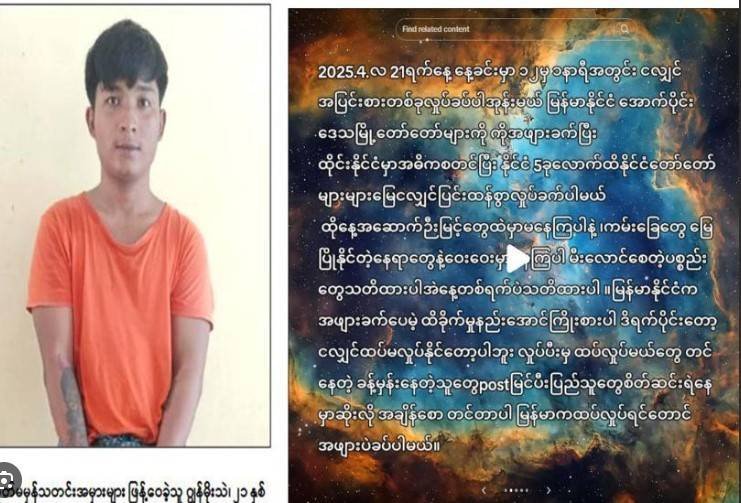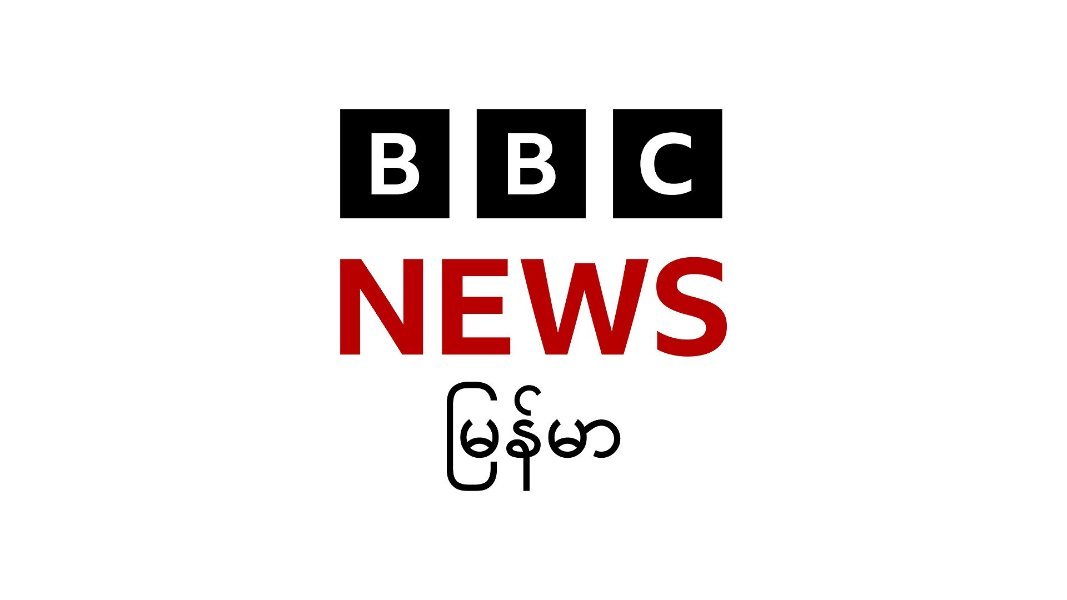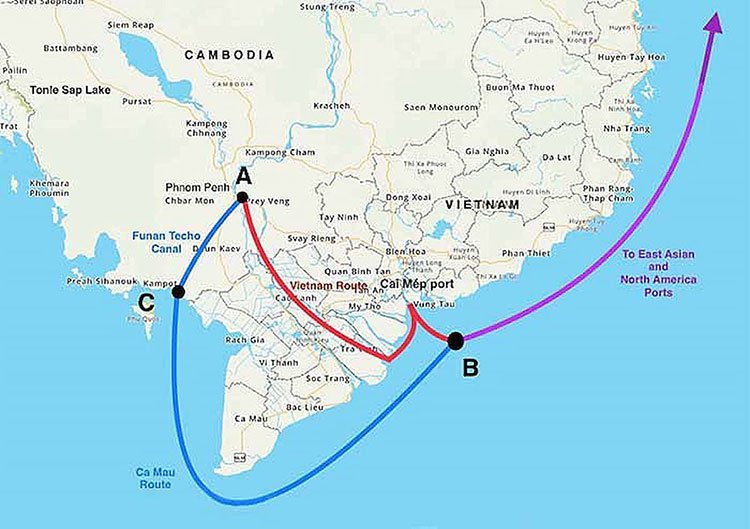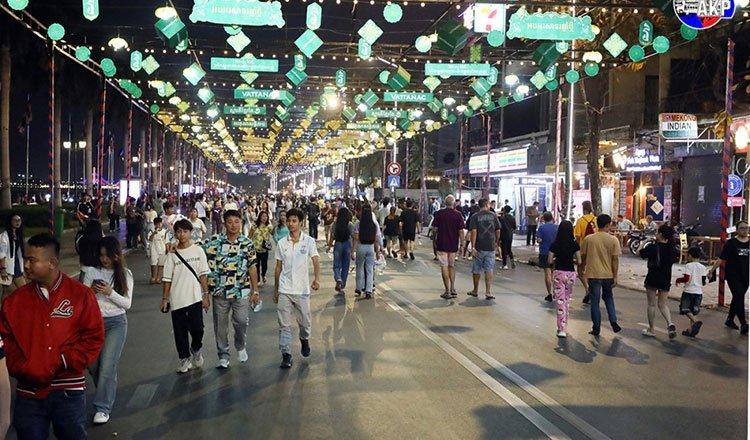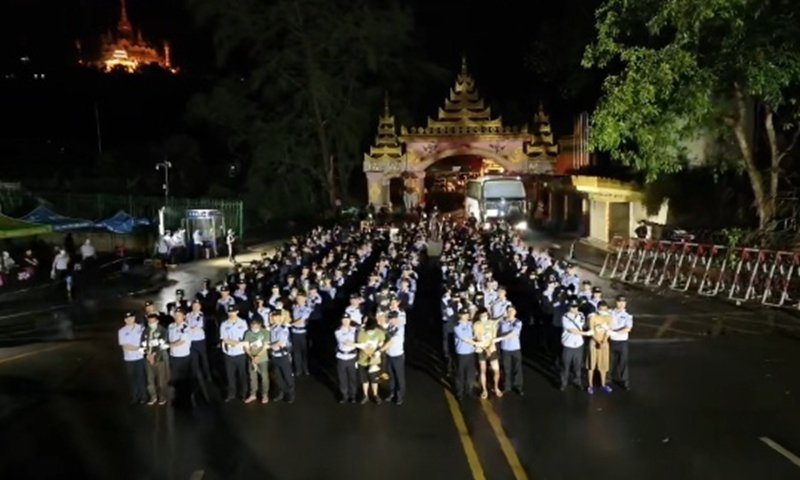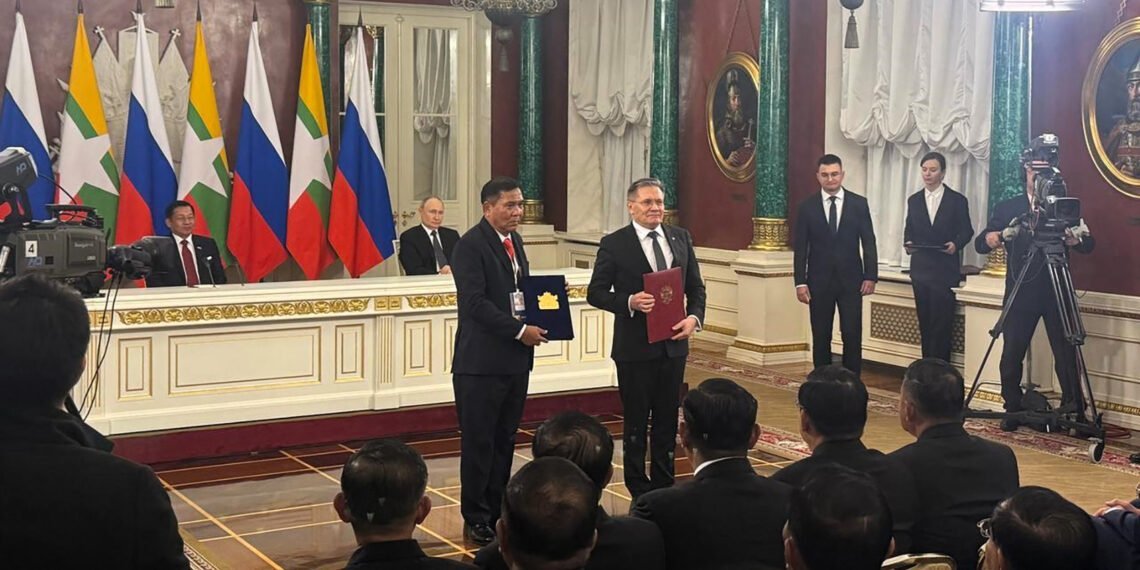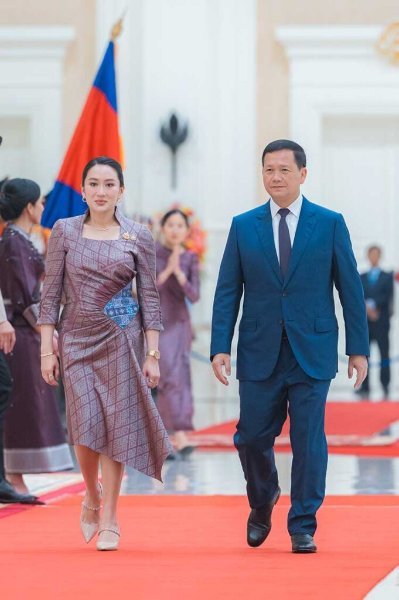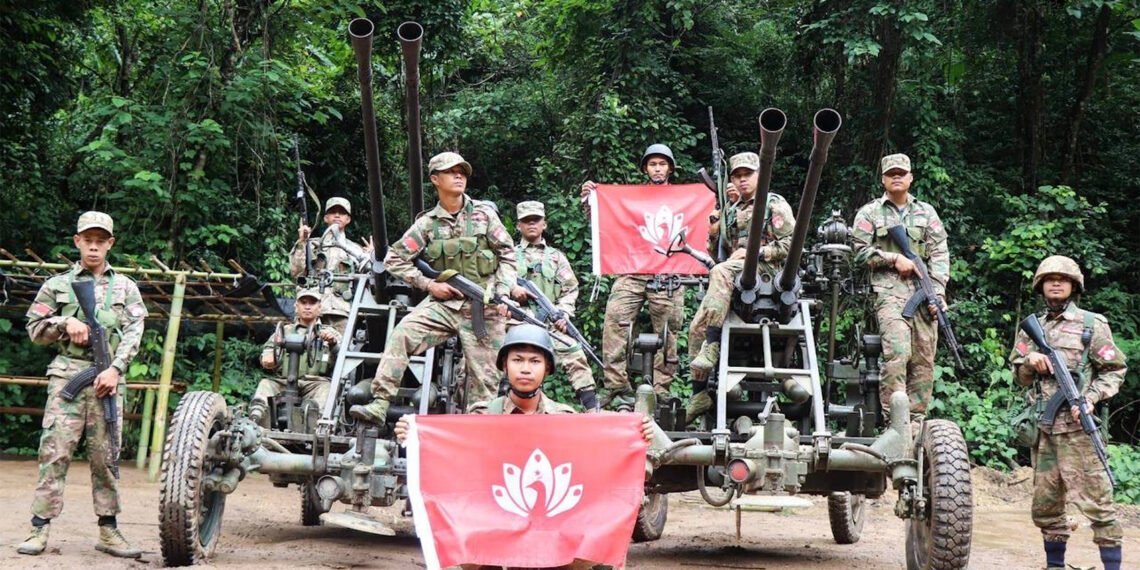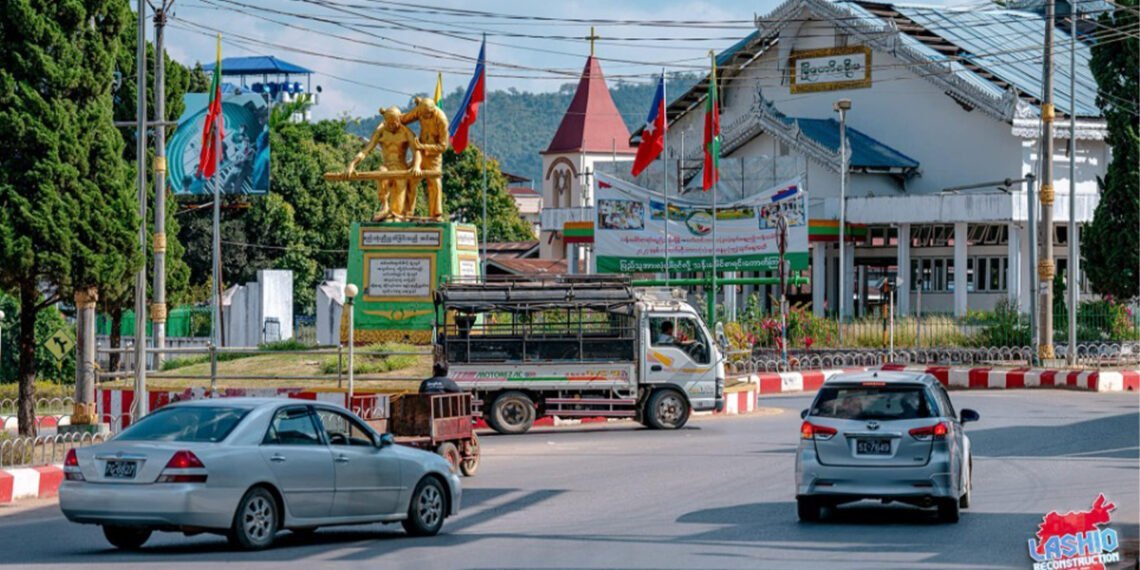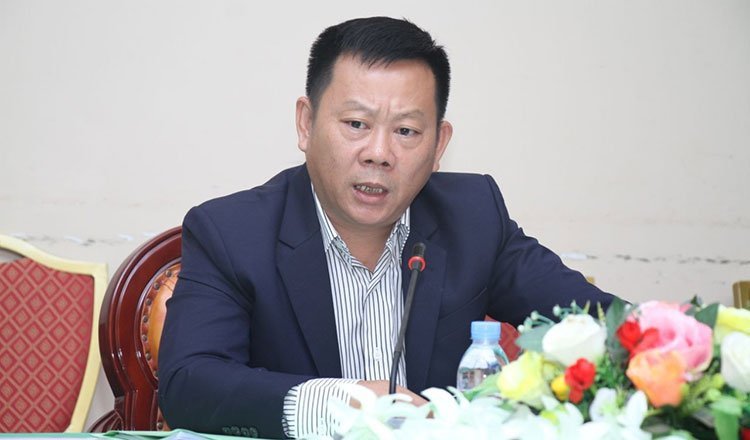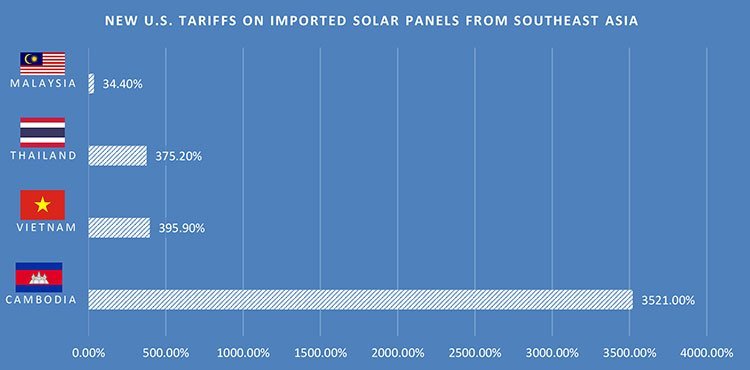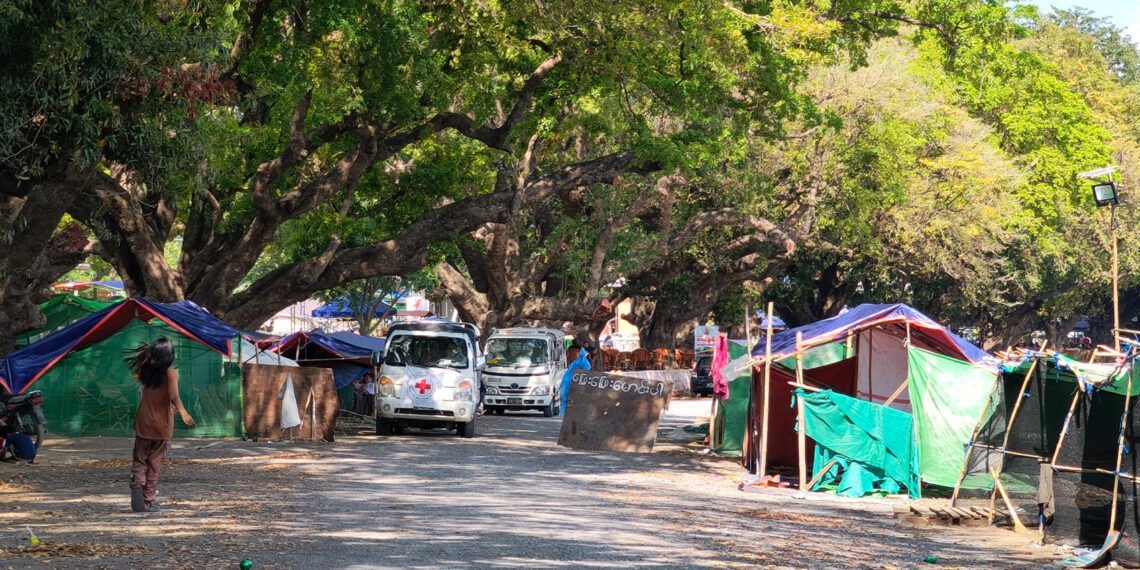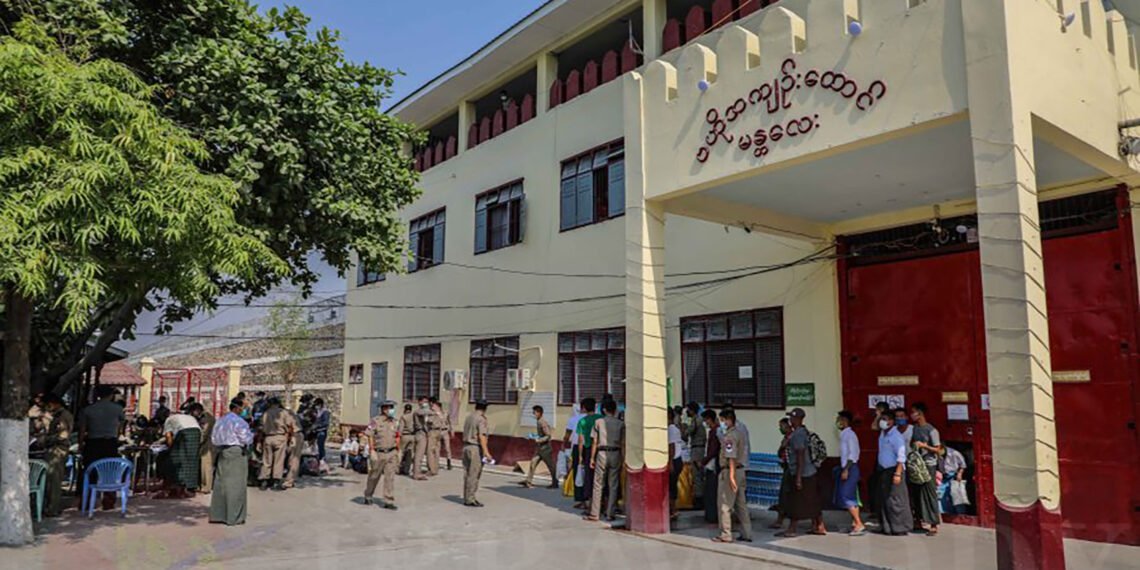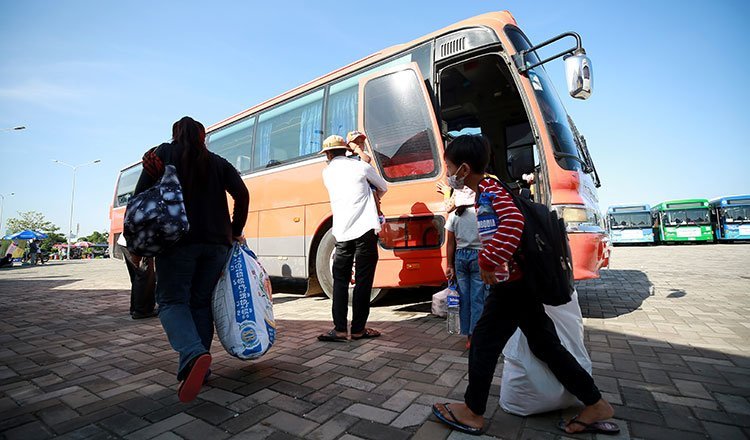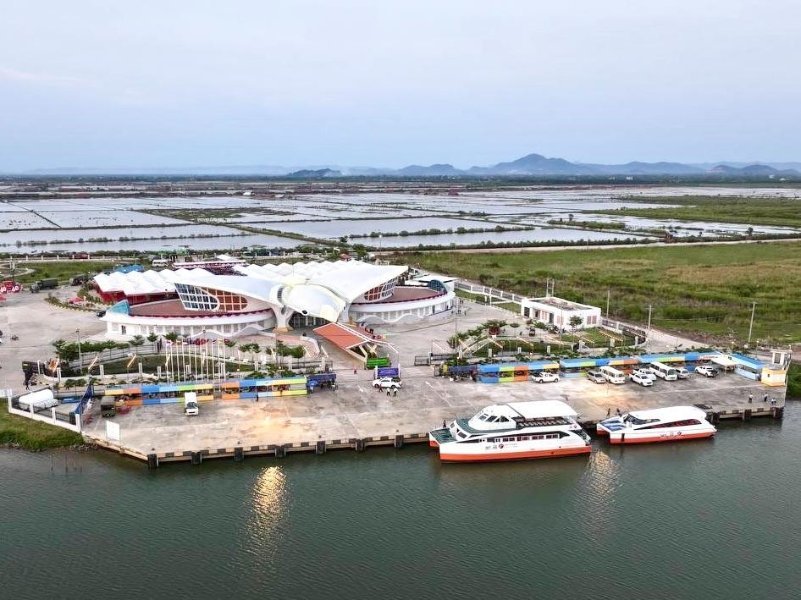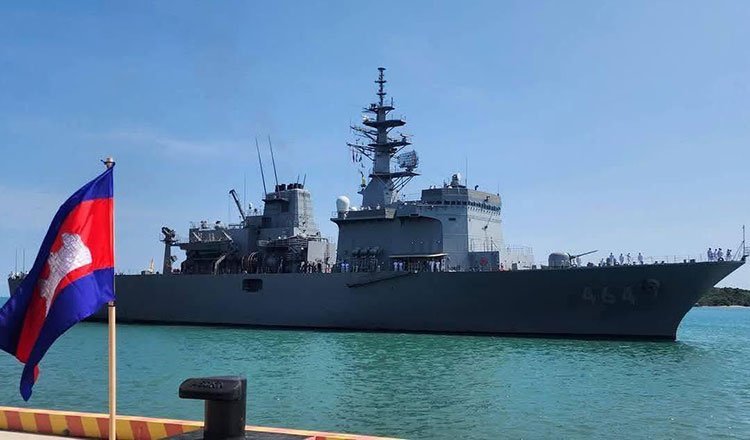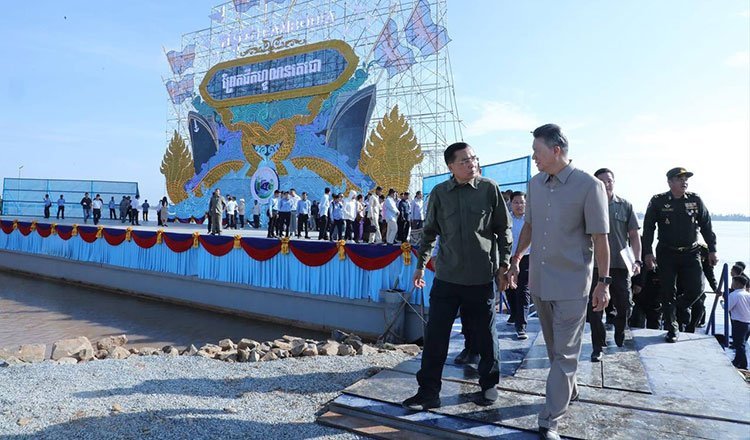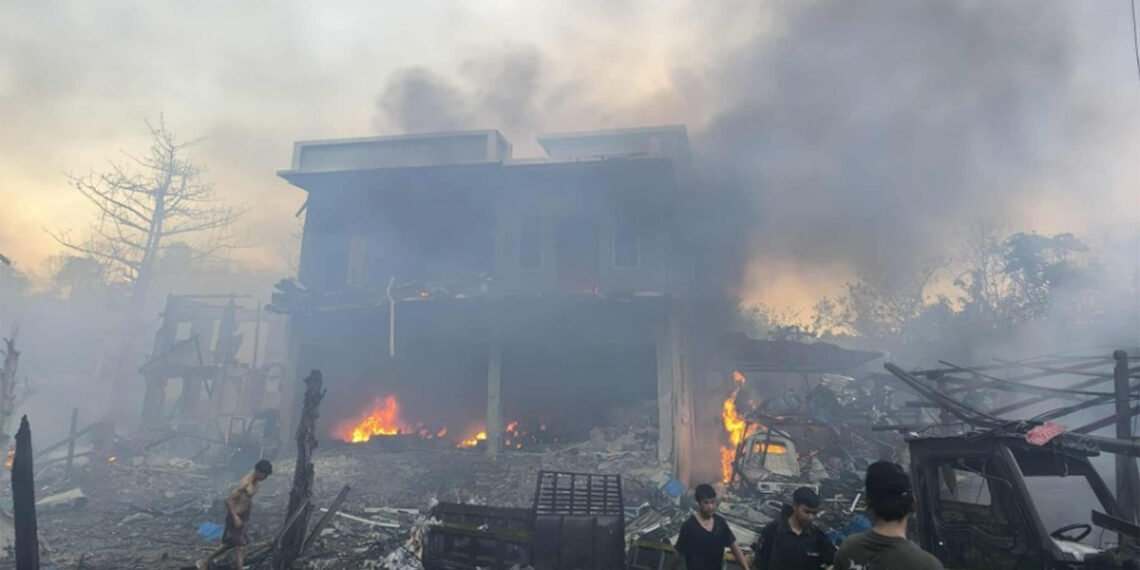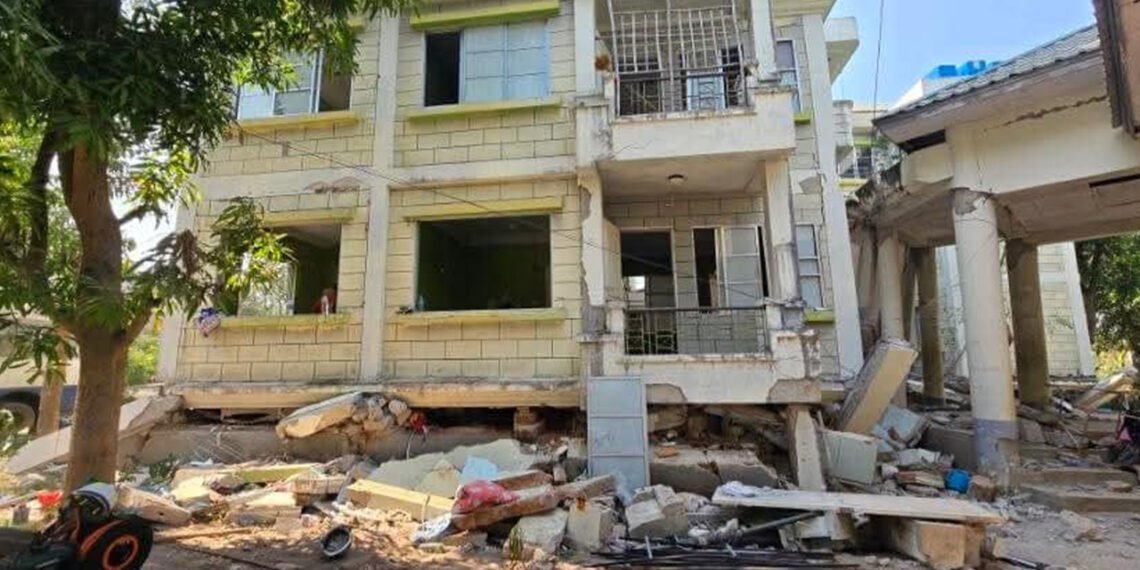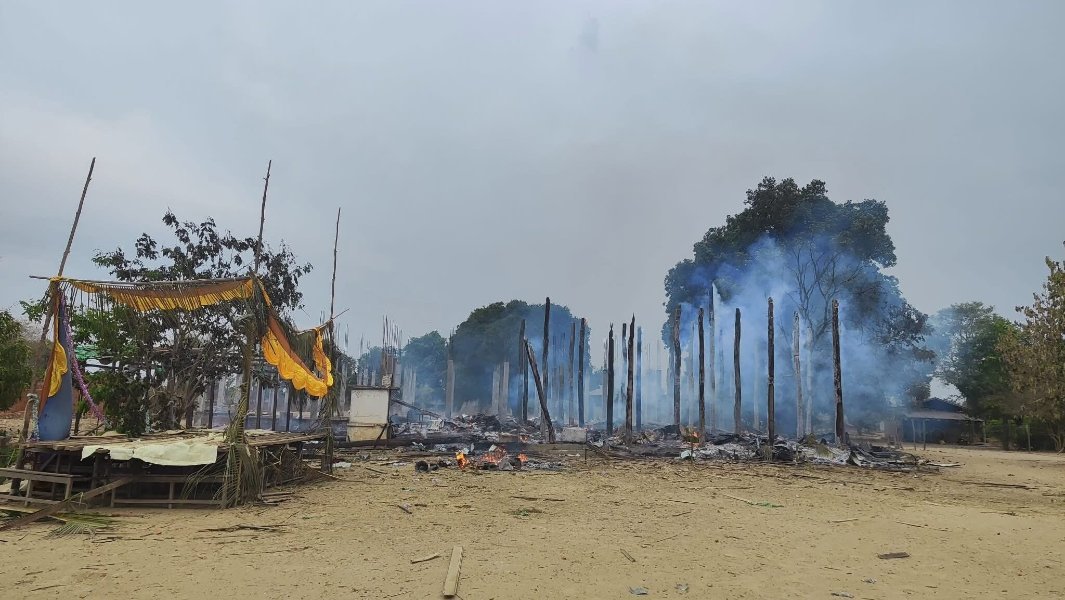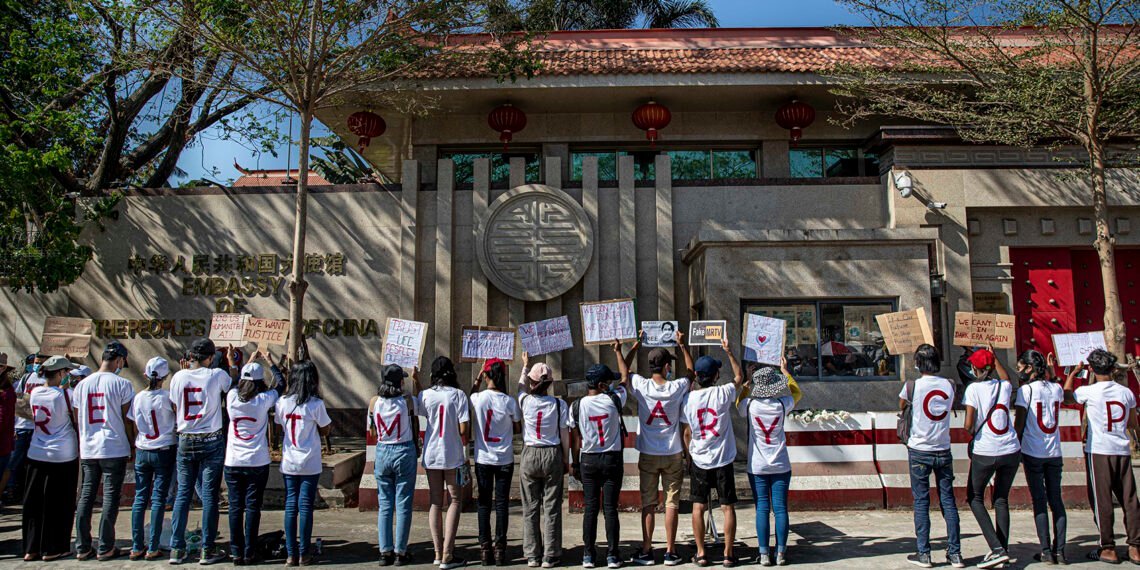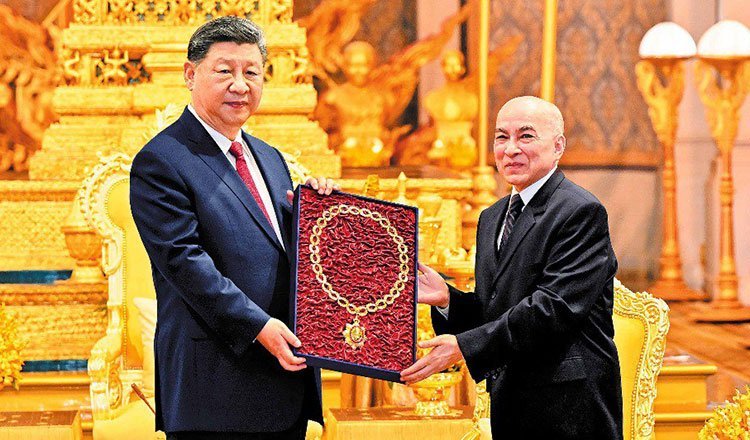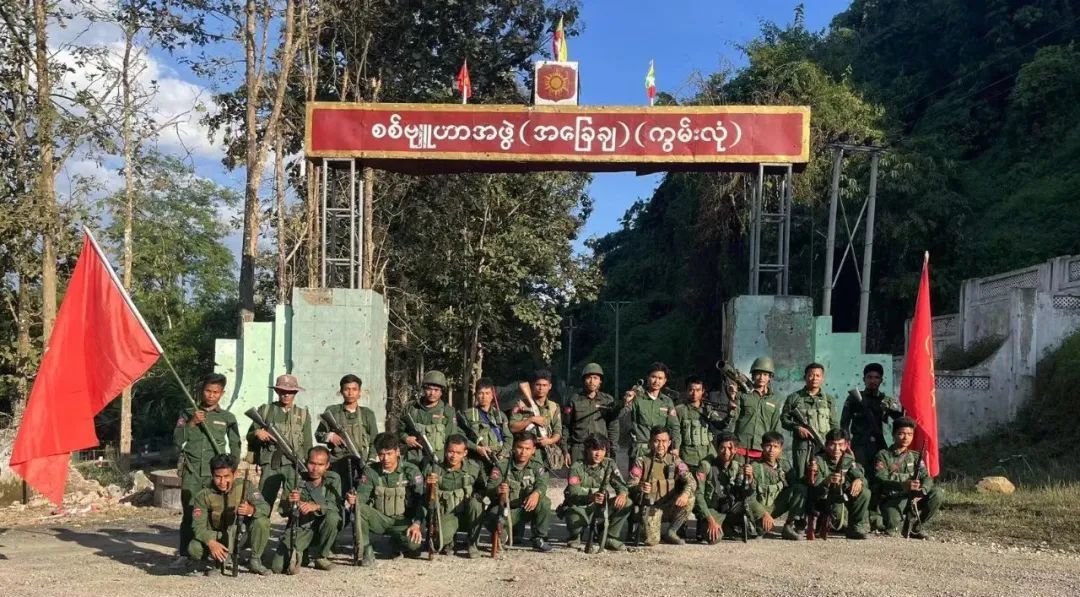-
Posts
15,785 -
Joined
-
Last visited
Content Type
Events
Forums
Downloads
Quizzes
Gallery
Blogs
Everything posted by geovalin
-
Screen capture A popular Myanmar TikTok astrologer has been arrested after his viral prediction of another powerful earthquake triggered widespread panic, weeks after a deadly tremor devastated the country. John Moe The, a 21-year-old with over 300,000 followers on TikTok, posted a video on 9 April claiming a “very strong” quake would strike “every city in Myanmar” within 12 days. The video, viewed more than 3.3 million times, warned residents to flee tall buildings and be prepared to evacuate. The forecast came just weeks after a 7.7-magnitude earthquake struck central Myanmar, killing over 3,700 people and displacing tens of thousands. With aftershocks still rattling the region, Moe The’s prediction stoked fresh fear in an already traumatised population. Myanmar’s military authorities confirmed on Thursday that Moe The was arrested during a morning raid in the city of Monywa earlier this week. In a statement published in state media, the government accused him of spreading fake news and pledged to take action against anyone “who writes or shares” such information. "Action will be taken effectively according to the law," the statement said. Though some dismissed the astrologer’s forecast, others took it seriously. “Most of my neighbours dared not to stay in their apartments and lived out on the street on that day,” said Yangon resident Nan Nan. “My friend even hired a small house outside the city in preparation.” Moe The, who posts under the name “John (Palmistry),” regularly shares astrological predictions over cosmic imagery. His claims have included weather disasters, the return of Aung San Suu Kyi, and US airstrikes on Myanmar—none of which have come to pass. Despite the popularity of fortune-telling in Myanmar, experts have firmly rejected the idea that earthquakes can be predicted. “Neither the USGS nor any other scientists have ever predicted a major earthquake,” reads a statement from the United States Geological Survey. “We do not know how.” In a country already battling civil war, a natural disaster, and fragile infrastructure, the spread of misinformation has only heightened tensions. Relief efforts remain hampered by damaged roads and ongoing conflict, with more than 60,000 people still living in makeshift camps. The incident underscores how misinformation on social media can have real-world consequences—especially in regions where official communication is limited, and trust in state institutions is low. -2025-04-25
-
- 1
-

-
The BBC has stepped in to fill a critical news void in Myanmar, launching a satellite channel in Burmese following the collapse of US-backed broadcasts and a devastating earthquake. The new BBC News Burmese channel, to be delivered via the Thaicom 6 satellite, comes just weeks after Donald Trump’s administration abruptly ended funding for Voice of America (VOA), silencing one of Myanmar’s few remaining independent news sources. The BBC will now take over VOA’s former satellite slot to reach audiences left cut off during a time of crisis. The move follows a catastrophic 7.7-magnitude earthquake near Mandalay in March that killed over 3,000 people. In the days that followed, digital traffic to the BBC’s Burmese service surged, highlighting the desperate demand for reliable information. “In Myanmar, where press freedom is severely restricted and a brutal conflict rages, we now have an audience also devastated by natural disaster,” said Jonathan Munro, deputy chief executive of BBC News. “This service will offer vital, trusted reporting to those trying to rebuild their lives.” The new channel will feature BBC television, radio, and digital content in Burmese, and provide QR code access to its wider online coverage. It’s aimed at a population that has long relied on foreign broadcasters to access independent journalism amid increasing state censorship. VOA, historically one of the world’s most prominent public service broadcasters, ceased its Myanmar satellite transmissions just before the quake. The Trump administration has accused it of spreading “radical propaganda,” despite its legacy of countering authoritarian disinformation since World War II. Although a US judge has since ordered funding to be restored, its long-term future remains uncertain. The BBC’s intervention underscores growing concerns over access to impartial news in one of the world’s least free media environments—Myanmar ranks 171st out of 180 countries for press freedom. Former VOA contributor Sithu Aung Myint is currently serving a 12-year sentence under charges of “anti-state” reporting. While the BBC’s move is widely welcomed, it comes at a cost. The World Service, already under financial strain since the Foreign Office stopped funding it in 2014, now faces fresh pressure to sustain its global reach with dwindling resources. Nonetheless, for thousands in Myanmar reeling from tragedy and isolation, the BBC’s return to satellite broadcasting offers a rare and urgently needed lifeline of truth. -2025-04-25
-
A newly signed deal between Cambodia and China to build a $1.7 billion canal has drawn sharp questions from regional stakeholders, amid fears over its potential impact on the fragile Mekong Delta ecosystem. The Funan Techo Canal, backed by Chinese state giant CCCC with a 49% stake, is set to stretch 180 km from the Mekong Basin to Cambodia’s southern coast. Promoted as a boost for irrigation and economic development, the project has faced scrutiny over environmental risks—particularly from Vietnam, whose rice-growing delta lies downstream. Despite the scale and geopolitical weight of the project, Cambodia has so far only provided “basic information,” according to the Mekong River Commission (MRC), which oversees sustainable development of the transnational river. The Commission is now urging Phnom Penh to release full feasibility and impact studies to ensure broader basin concerns are addressed. Environmentalists and experts warn that diverting water from the Mekong could worsen drought and salinity in Vietnam’s delta, already suffering from upstream dam activity. The Delta is not only a vital ecological zone but also a cornerstone of Vietnam’s rice exports. Cambodia insists the canal complies with the 1995 Mekong Agreement, but the MRC says the legality depends on whether the canal directly affects the river’s mainstream flow. “Guidance has been offered,” the Commission said, calling for further transparency from all parties. China’s role in the project, formally confirmed during President Xi Jinping’s recent visit to Cambodia, signals a deeper geopolitical footprint in Southeast Asia’s water infrastructure. Although Xi made no public mention of the canal, a joint communique cited Chinese support based on “feasibility and sustainability.” The canal’s scope appears to have shifted from its original navigation-focused design to one prioritising irrigation. Experts like Brian Eyler of the Stimson Center warn that the volume of water diverted may now be “much more than previously described.” As construction plans advance, the absence of clear environmental data and regional dialogue risks turning a national infrastructure project into a flashpoint for cross-border tensions. The coming months will be critical in determining whether the canal becomes a model of cooperation—or controversy. -2025-04-25
-
AKP Phnom Penh has earned a global spotlight, ranked second among the World’s Best Nightlife Cities by travel platform VISA2FLY—placing the Cambodian capital ahead of renowned party hotspots like Ibiza, Berlin, and New York. The city was praised for its eclectic nightlife scene that blends traditional Cambodian charm with modern flair. From riverside lounges and rooftop bars to hidden speakeasies and thumping nightclubs, Phnom Penh was hailed as “affordable, diverse, and electric,” making it a haven for both budget travellers and seasoned partygoers. “Cambodia’s nightlife is simply a perfect mesh of cultural warmth and modernity,” the report noted. It also contrasted Phnom Penh’s lively club culture with the more laid-back riverside vibe of Siem Reap, showcasing the country’s broad appeal. Bangkok claimed the top spot, while Phnom Penh’s regional neighbours Bali, Ho Chi Minh City, and Dubai rounded out the top five. The Ministry of Tourism attributed the city’s rising nightlife profile in part to the success of initiatives like Chaktomuk Walk Street, a recently launched pedestrian zone near the riverside that’s become a weekend nightlife hub. Officials say the international recognition is more than a popularity contest—it’s a sign of Cambodia’s growing stature on the global tourism map. With its mix of culture, cuisine, and after-dark energy, Phnom Penh is no longer just a stopover—it’s a destination in its own right. As international borders continue to ease and travel rebounds, Cambodia’s capital seems ready to dance well into the global limelight. -2025-204-25
-
CCTV Myanmar has transferred more than 920 Chinese nationals accused of telecom fraud to Chinese authorities, as part of a sweeping joint crackdown on cross-border scams, China’s Ministry of Public Security (MPS) confirmed on Wednesday. The suspects, apprehended in recent raids across southern Shan State, including in Tangyan and Mong Hsu, were handed over at the Daluo border checkpoint in Yunnan Province. The operation represents a significant escalation in efforts by both nations to target increasingly elusive telecom fraud networks operating deep within Myanmar’s territory. This latest handover follows the reported dismantling of large-scale scam operations near the China-Myanmar border. Yet, authorities say many fraudsters have since moved further into Myanmar, setting up new “fraud dens” to avoid detection while continuing to target Chinese victims. Since March 24, Myanmar has conducted several intensive raids with Chinese support, seizing thousands of devices used in scams—including computers, phones, bank cards, and detailed fraud scripts. According to Chinese officials, the cooperation between both countries has so far led to the arrest of over 55,000 suspects connected to these crimes. “The message is clear,” a spokesperson for the MPS said. “No fraud criminal, no matter where they hide, is beyond the reach of the law.” The ministry added that local Chinese authorities have been instructed to carry out full investigations, and urged suspects still at large to surrender in exchange for possible leniency. Beijing and Naypyitaw have pledged to maintain “persistent pressure” on these criminal syndicates, which have flourished in Myanmar’s conflict-affected regions amid weak governance and law enforcement gaps. While the crackdown has been praised by Chinese officials, rights groups and regional analysts remain wary of the opaque legal processes involved and the fate of those detained. Nonetheless, the sheer scale of arrests signals that telecom fraud is now seen as a top-tier security threat by both governments. With joint enforcement tightening, China is sending a blunt warning to fraud networks: relocation offers no refuge. -2025-04-24
-
- 1
-

-

Russia Backs Myanmar Nuclear Plant Despite Quake Devastation
geovalin posted a topic in Myanmar News
Rosatom Russia’s state nuclear agency Rosatom has confirmed it will move forward with plans to build Myanmar’s first nuclear power plant, even as Naypyitaw grapples with the aftermath of a deadly earthquake that left much of the capital in ruins. “The recent earthquake has not affected Rosatom’s plans in Myanmar,” the company stated this week, insisting its reactor designs meet stringent international standards, including seismic resistance. The announcement follows a high-level agreement between junta chief Min Aung Hlaing and Russian President Vladimir Putin during the Myanmar leader’s visit to Moscow in March. The deal formalised a years-long ambition to establish nuclear power in the country, despite deepening political instability and widespread opposition at home. Rosatom’s Director General Alexey Likhachev confirmed the reactor would be located near Naypyitaw, the city worst hit by the 7.7-magnitude quake on 28 March. The disaster, which struck just three weeks after Min Aung Hlaing returned from Russia, killed over 3,700 people—many in the capital—and levelled key government buildings, including the presidential residence and parliament. With much of Naypyitaw in ruins and ministries considering relocation to Yangon, the junta’s focus on nuclear expansion has raised eyebrows. Soil testing for reconstruction is already underway, yet details of the nuclear project remain tightly guarded, including timelines and safety protocols. Local fears are mounting over the wisdom of installing a nuclear facility in a seismic zone. The government’s assurances that the plant will serve only peaceful purposes have been met with scepticism, particularly in light of the military’s continued attacks on resistance-held areas and its poor disaster response record following Cyclone Mocha and recent floods. Observers warn that the nuclear project could exacerbate public distrust and stoke fears over potential militarisation. The regime has long harboured nuclear ambitions, dating back to the era of former dictator Than Shwe, and now faces accusations of prioritising power projection over public welfare. With much of the country in conflict and civilian casualties mounting from junta airstrikes, critics say the timing—and location—of the nuclear plan couldn’t be more perilous. -2025-04-24 -
Facebook collected by Phnom Penh Post Nearly 100 Cambodian women trafficked to China have been rescued and returned home since the start of 2025, shedding new light on the persistent threat of human trafficking across Asia and prompting renewed calls for vigilance. In an update issued on April 22, Cambodia’s General Department of Immigration (GDI) confirmed that 98 citizens—97 of them women and girls—have been repatriated from China in 42 separate trafficking cases this year. Of those, 59 have been reunited with their families, while 39 remain under state care for further support and reintegration. The news underscores the scale and complexity of the trafficking crisis affecting vulnerable Cambodians, particularly women lured abroad under false promises of marriage or employment. Many victims fall prey to transnational criminal networks exploiting legal migration routes. The GDI also addressed rising concerns online, rejecting claims that immigration officials were unlawfully preventing women from travelling abroad. Officials insisted that while Cambodia upholds citizens’ freedom to travel, steps are being taken to identify potential trafficking victims before departure—especially in cases involving young women heading to China. Authorities said that from January to April, 107 people—82 of them women—were stopped at border checkpoints on suspicion of trafficking involvement. The vast majority were Cambodian. At Phnom Penh International Airport alone, 75 individuals were intercepted in 36 separate cases. “Interviewing and prohibiting certain Cambodian citizens, especially women marrying foreigners or intending to work abroad, is not about restricting their freedom,” the department said in a statement. “These measures aim to protect citizens from being deceived and exploited by traffickers.” The statement urged citizens to remain vigilant against recruitment scams and illicit brokers who prey on economic desperation, especially among young women in rural areas. The government continues to crack down on such schemes, though campaigners argue more regional cooperation and legal protections are urgently needed. While the latest repatriations offer a measure of relief, the underlying conditions that fuel trafficking—including poverty, lack of opportunity, and weak cross-border enforcement—remain a serious concern for Cambodian authorities and rights groups alike. -2025-04-24
-
Thailand’s Prime Minister Paetongtarn Shinawatra arrived in Phnom Penh on Wednesday for a landmark two-day official visit aimed at strengthening bilateral cooperation, even as human rights groups raised concerns about the treatment of political dissidents in the region. Welcomed at the airport by Cambodian officials including Commerce Minister Cham Nimul, Shinawatra, joined by her husband Pitaka Suksawat, began a tightly scheduled programme that includes a Royal Audience with King Norodom Sihamoni and meetings with top Cambodian leaders such as former Prime Minister Hun Sen and National Assembly President Khuon Sudary. Central to the visit is a high-level meeting with Prime Minister Hun Manet, during which the two leaders signed several agreements on workforce development, road infrastructure, cross-border bridges, and pollution control. The event coincides with the 75th anniversary of diplomatic relations between the neighbouring countries, marking a period of intensified cooperation. Despite warm displays of diplomacy, the visit is shadowed by mounting international scrutiny. Human Rights Watch has accused both governments of engaging in what it terms a “swap mart”—reciprocal efforts to silence political opponents through deportations, disappearances, and harassment. The group called on Prime Minister Shinawatra to press her Cambodian counterparts to end such practices and uphold human rights protections. In a joint press conference, Hun Manet thanked Thailand for not allowing dissidents to use its territory to interfere in Cambodian affairs, pledging a reciprocal stance. His remarks, however, have drawn criticism amid accusations that both nations are complicit in suppressing political opposition, often in defiance of international legal standards. Incidents such as the 2020 disappearance of Thai activist Wanchalearm Satsaksit in Phnom Penh and the unresolved killing of Cambodian opposition figure Lim Kimya in Bangkok earlier this year have underscored these concerns. While the agreements signed this week may signal a deepening of state-level collaboration, rights groups argue that true progress will require a commitment to justice and transparency—an element that remains elusive in current cross-border relations. -2025-04-24
-
MDY-PDF Myanmar’s military regime has extended a fragile ceasefire until 30 April to allow relief efforts to continue following last month’s devastating earthquake, state media announced on Tuesday. The move comes after a 7.7 magnitude quake struck near Mandalay on 1 April, killing more than 3,700 people and flattening entire communities in one of Southeast Asia’s poorest countries. The disaster has compounded the nation’s already dire humanitarian crisis, with much of the infrastructure damaged and access to aid limited by ongoing conflict. Junta leader Min Aung Hlaing initially called a 20-day ceasefire earlier this month “out of sympathy and understanding for the people affected,” according to state broadcasts. The extension is meant to facilitate rescue, rebuilding, and aid delivery in quake-hit regions. Despite the truce, reports from the United Nations and humanitarian organisations suggest that military activity has continued in parts of the country, including airstrikes. This has raised concerns over the sincerity of the ceasefire and its effectiveness on the ground. Myanmar has been in turmoil since the 2021 coup that ousted Aung San Suu Kyi’s elected government, triggering nationwide protests that evolved into a broad armed resistance. The conflict has displaced over two million people and left vast areas of the country inaccessible to international aid. The ceasefire extension follows rare talks held last week between Malaysia’s Prime Minister Anwar Ibrahim, junta officials, and a major resistance group. As current chair of ASEAN, Anwar has pushed for humanitarian access and dialogue, though the bloc has struggled to make meaningful inroads in resolving the crisis. As relief teams race to assist survivors in Mandalay and surrounding areas, aid workers continue to call for unrestricted access and a genuine commitment to peace. While the junta’s gesture may signal a temporary easing of tensions, many fear it could be short-lived—another pause in a war that has devastated lives and tested the limits of regional diplomacy. -2025-04-23
-
Lashio Rebel forces in Myanmar are preparing to hand the strategic city of Lashio back to the military, just eight months after seizing it in a major blow to the junta—marking a dramatic shift in the country’s ongoing civil war. The Myanmar National Democratic Alliance Army (MNDAA) captured Lashio in August 2024, ousting the military from its northeastern command hub and disrupting key trade routes with China. Analysts called it the junta’s most severe loss since the 2021 coup plunged the nation into conflict. Now, under quiet Chinese mediation, the MNDAA appears poised to surrender the city without a fight. “At the joint invitation of both sides, China recently dispatched a ceasefire monitoring team to Lashio,” Chinese foreign ministry spokesman Guo Jiakun confirmed this week, adding that Beijing would “witness the smooth and orderly handover.” China has long walked a delicate line in Myanmar, supplying arms to the military regime while maintaining ties with ethnic armed groups like the MNDAA, whose territory lies just 100 kilometres from the Chinese border. The rebels have remained tight-lipped, but reports from Lashio suggest the handover is already in motion. A resident said MNDAA members were seen meeting military officials inside a hotel, while a local ethnic group allied with the rebels reported an influx of military vehicles. A junta source confirmed officers have been redeployed to the city in recent days. The move comes after Beijing reportedly cut off water, power and internet to the MNDAA’s Kokang stronghold following Lashio’s fall—signalling Chinese displeasure with instability so close to its Belt and Road investment corridors. The MNDAA, along with allied ethnic forces, had launched a major offensive in late 2023, capturing swathes of Shan State and tightening control over cross-border trade routes and lucrative gem mines. While the upcoming handover may restore Lashio to junta hands, it underscores China’s growing influence in Myanmar’s volatile north—and highlights how regional powers are shaping the conflict’s future as much as the fighters on the ground. -2025-04-23
-
Cambodian gvt In a powerful act of cultural diplomacy, Thailand has agreed to return 20 looted artefacts to Cambodia—precious pieces of Khmer heritage that were smuggled abroad during years of conflict and instability. Most of the items, primarily small sculptures and temple relics, were illicitly taken from archaeological sites across Cambodia. Now, after sustained negotiations, Thai authorities have committed to their repatriation, marking a significant moment in the region's efforts to restore historical justice. “These 20 artefacts are part of a larger collection illegally excavated and trafficked over decades,” said Sum Mab, spokesperson for Cambodia’s Ministry of Culture and Fine Arts. “They will be conserved as part of our national heritage.” The formal handover is scheduled for July 2025, with the artefacts expected to arrive in Cambodia by August. The announcement comes ahead of an official visit by Thai Prime Minister Paetongtarn Shinawatra, who is meeting with Cambodian leadership this week to celebrate 75 years of diplomatic relations between the two nations. Cambodian Prime Minister Hun Manet has called the gesture symbolic of growing trust and friendship, highlighting that cultural cooperation will be central to talks during Paetongtarn’s two-day visit. The Thai premier is also set to meet King Norodom Sihamoni and other senior Cambodian leaders. For Cambodia, the return of these artefacts is more than ceremonial. Many of the country’s ancient treasures were scattered across private collections and international markets during its turbulent past. Some were seized by Thai officials, while others have required years of quiet diplomacy to retrieve. “These artefacts are not just historical objects—they are the soul of our ancestors,” said Minister of Culture Phoeurng Sackona. “This process is a vital step towards cultural justice and the preservation of Khmer identity.” The return from Thailand joins broader efforts involving the United States and China, as Cambodia seeks to recover its stolen past, piece by piece. -2025-04-23
-
Khmer Times Cambodia’s solar panel exports have been hit with a staggering 3,521% U.S. tariff—the highest ever imposed in the sector—as Washington cracks down on what it calls unfair trade practices in Southeast Asia. The decision, announced Monday by the U.S. Department of Commerce, finalises year-long investigations into claims that Chinese-owned companies were using factories in Cambodia, Vietnam, Thailand, and Malaysia to flood the U.S. market with underpriced, heavily subsidised solar products. Cambodian manufacturers were penalised most harshly for failing to cooperate with the inquiry, resulting in the eye-watering duty. By contrast, tariffs for Malaysian firms like Jinko Solar sit at 41.56%, while Thai operations linked to Trina Solar face rates of 375.2%. Vietnam’s average tariff comes in at just under 396%. “These are very strong results,” said Tim Brightbill, counsel for the American Alliance for Solar Manufacturing. “They address years of unfair competition that have damaged U.S. industry.” Cambodia’s solar exports have already suffered. Last year, shipments dropped to $830 million—down from over $2 billion in 2023—after the Biden administration began rolling back trade exemptions. While the country’s industry isn’t dominated by major Chinese manufacturers, it’s believed that some Chinese integrators and assemblers operate locally, complicating the issue of ownership and accountability. Despite the punitive measures, final enforcement depends on a ruling from the U.S. International Trade Commission, expected by 2 June. If confirmed, the tariffs could reshape global solar trade, as Southeast Asia accounted for over $12 billion in U.S. imports in 2023 alone. Experts warn the fallout may be twofold: a win for American producers, but a blow to businesses and consumers who’ve benefited from cheap solar equipment. Meanwhile, analysts say Cambodia could look to emerging markets in the Middle East and Africa to offset losses. While the long-term impact remains unclear, one thing is certain—this unprecedented tariff marks a seismic moment for Cambodia’s growing solar industry. -2025-04-23
-
The Irrawaddy Nearly 250,000 internally displaced people (IDPs) sheltering in Mandalay have been excluded from official earthquake relief efforts, according to aid volunteers and residents, deepening the humanitarian crisis sparked by the devastating 28 March quake. Fleeing conflict in Shan State and Sagaing Region, many IDPs had sought safety in Myanmar’s second-largest city—only to find themselves overlooked by junta-led relief efforts. Local officials have reportedly limited aid distribution to registered Mandalay residents, leaving displaced families without shelter or food. “We’re treated like we don’t exist,” said a woman displaced from Sagaing’s Kawlin Township. “My house back home was burned down. Now I’ve lost my rented shelter in Mandalay too. The only help we’ve had is a few packets of rice and curry from donors.” Most IDPs had been living in rented accommodation that was severely damaged or destroyed by the quake. Volunteers estimate that at least 300 displaced people were killed in the disaster, while survivors are now seeking refuge in monasteries, roadside tents, or crowded temporary camps. According to a volunteer in Amarapura, just outside Mandalay, relief is being distributed based on household registration documents—meaning IDPs, who are not formally registered in the city, are systematically excluded. “Even when several families share a house, only the officially registered ones receive aid,” he said. The official response has been minimal. Rescue operations in Mandalay ended just ten days after the quake, and victims say they are receiving little support beyond what civil society groups and individual donors can provide. The scale of destruction is vast: over 60,000 homes, more than 2,300 schools, and thousands of religious and public buildings were damaged across Mandalay, Sagaing, Naypyitaw, and southern Shan State. The confirmed death toll has climbed to 3,725, with over 5,100 injured and 129 still missing. Meanwhile, many residents fear aftershocks—over 140 have been recorded—forcing them to sleep in schools, open fields, and even on roadsides. With the regime focused on controlling information and restricting aid, Myanmar’s displaced communities face a grim reality: abandoned in crisis, and left to survive with little more than solidarity and scraps. -2025-04-22
-
- 1
-

-
Obo prion BEFORE the eathquake At least 30 inmates—including 20 political prisoners—were killed when a powerful earthquake struck central Myanmar on 28 March, according to a coalition of human rights organisations. In a joint statement released Sunday, seven groups supporting political detainees, including the Political Prisoners Network-Myanmar and the Assistance Association for Political Prisoners, confirmed the fatalities and reported over 280 injuries within the prison system. The worst-hit was Obo Prison in Mandalay, where ageing and poorly maintained facilities collapsed during the quake. Obo, Myanmar’s second-largest prison, houses thousands of inmates, many of whom are political detainees jailed by the military regime. The groups allege the junta has enforced a media blackout on prison casualties and threatened to forcibly relocate political prisoners who refuse to remain in damaged blocks to Tharyarwaddy Prison in Bago—further from family support networks and access to essentials like food and medicine. “No aid has reached political prisoners affected by the disaster,” the statement said, citing the lack of both local and international assistance. “Injured inmates are being denied proper medical treatment, and some are suffering without basic care.” Among the worst structural losses were two women’s cell blocks, a hospital wing, and a men’s workshop, all of which reportedly collapsed during the tremor. The total death toll from the 6.8-magnitude quake has now risen to 3,735, with more than 5,100 injured and 120 still missing, according to figures released by the military government. Human rights advocates are urging the United Nations and international humanitarian agencies to investigate the treatment of detainees and press the junta for transparency and accountability. With thousands still detained for political activism since the 2021 coup, the earthquake has cast a grim spotlight on the regime’s neglect and the fragile conditions in Myanmar’s prisons. -2025-04-22
-
- 1
-

-
KT Sukunthea Cambodian Prime Minister Hun Manet has revealed that the government’s free public bus service during Khmer New Year saved citizens nearly $2 million, easing travel costs and strengthening community ties. Speaking at the inauguration of Kampot’s new International Tourist Port, the Prime Minister said more than 85,000 people travelled across the country during the week-long holiday using government-provided transport. In total, 2,251 bus trips were made, saving passengers an estimated $1.7 million. “This initiative allowed many Cambodians to reunite with their families without worrying about the cost,” Hun Manet said. “It is part of our ongoing effort to support people in meaningful, practical ways.” The free service, operated largely by the Phnom Penh administration using nearly 600 buses, ran from April 11 to 17. The scheme was praised not just for its cost-saving benefits but also for improving road safety. The PM noted a 40% drop in traffic accidents compared to last year, crediting local authorities for maintaining order and security during the festivities. Phnom Penh Deputy Governor Koeut Chhe said the initiative aimed to reduce financial pressure, enabling people to return to their hometowns for one of Cambodia’s most important cultural celebrations. Passengers welcomed the service. Thong Srey Roth, who travelled to Kampong Thom, said she saved $25 thanks to the scheme. “I use the free buses every year. They’re safe, comfortable, and allow me to spend the holiday with my family,” she said. The Khmer New Year, rich with cultural tradition and family gatherings, often sees a nationwide migration. By removing transport costs, the government made it easier for thousands to travel, reinforcing the holiday’s spirit of unity. As Cambodia looks to strengthen its infrastructure and public services, the success of the free bus programme highlights the tangible benefits of targeted, people-centred policies. -2025-04-22
-
KT Cambodian Prime Minister Hun Manet has officially opened the Kampot International Tourist Port, using the occasion to deliver pointed remarks on tourism, foreign relations, and national unity. Speaking at the ceremony in Kampot, the PM hailed the new port as a milestone in regional tourism development. The facility, built with support from the Asian Development Bank, is part of a broader initiative to boost inclusive growth across the Greater Mekong Subregion. Although full international connectivity has not yet been achieved, Hun Manet emphasised the port’s success in promoting travel to popular Cambodian islands such as Koh Rong and Koh Sdach. “This is a step forward in connecting Cambodia’s coastlines with the world,” he said, noting that trial operations have already driven an uptick in tourist arrivals to the region. Beyond infrastructure, Hun Manet used his platform to respond to critics and defend Cambodia’s diplomatic approach—particularly in relation to China. He questioned those who rely on Chinese-funded infrastructure or work in Chinese-invested factories but still harbour negative views of Beijing. “Our relationship with China is based on mutual respect and the rule of law,” he said, stressing that Cambodia’s foreign policy is independent and inclusive. He pointed to Chinese President Xi Jinping’s upcoming visit as evidence of strong bilateral ties, while also reaffirming that Cambodia considers both China and the United States as valued partners. “We choose cooperation, not confrontation,” he said, highlighting China’s $28 billion investment in the US last year as proof of its global engagement. Turning to recent domestic criticism, the PM rejected claims that the government failed to promote Khmer culture during the New Year celebrations. “Many cultural programmes were organised,” he said, defending the government's efforts to uphold national traditions. In closing, Hun Manet reaffirmed his government’s commitment to continuous improvement: “We are not perfect, but we strive to build on what we’ve achieved—for the benefit of our people.” The dual focus on national development and balanced diplomacy underscores Cambodia’s current path: one that seeks progress at home while maintaining careful friendships abroad. -2025-04-22
-
Japanese Embassy PHNOM PENH — Two Japanese warships docked on Saturday at Cambodia’s newly expanded Ream Naval Base, in a high-profile visit aimed at signalling transparency amid U.S. concerns the facility could serve as a Chinese military outpost. The Bungo and Etajima, minesweepers from Japan’s Maritime Self-Defense Force, became the first foreign naval vessels to call at the base since a Chinese-funded upgrade was completed earlier this month. Their arrival, greeted by Cambodian officials including Rear Admiral Mean Savoeun, is seen as a diplomatic move to counter speculation about China’s exclusive access to the site. Ream Naval Base has drawn international scrutiny since a 2019 report suggested a secret agreement that could allow Beijing to station military assets there for up to 30 years. The Cambodian government has repeatedly denied granting China sole use of the facility, asserting that warships from any friendly nation may dock—if they meet set conditions. The Japanese Defence Minister, Gen Nakatani, framed the visit as a symbol of friendship and a step towards regional stability. "This port call supports an open, transparent naval presence and underscores the need for freedom of navigation and a rules-based international order," he said earlier in the week. The timing is notable, coming just a day after Chinese President Xi Jinping concluded a state visit to Cambodia, during which the two countries deepened strategic ties. Cambodia’s invitation to Japan is widely interpreted as an effort to demonstrate that Ream is not under exclusive Chinese control, especially as the United States continues to express alarm over China’s expanding military footprint across Southeast Asia. Japan’s embassy in Phnom Penh called the four-day stop a “historically significant event” for bilateral relations, part of a wider mission visiting 11 countries across Africa, the Middle East, and Asia. The visit also follows last year’s rare U.S. Navy stop at the nearby civilian port of Sihanoukville, further highlighting Cambodia’s balancing act between major powers in the region. -2025-04-21
-
Ministry of Information PHNOM PENH — Cambodia and China have signed a landmark $1.2 billion agreement to develop the Funan Techo Canal, a major infrastructure project aimed at transforming Cambodia’s transport and logistics landscape. The deal was inked on 17 April during Chinese President Xi Jinping’s state visit to Cambodia, in the presence of key Cambodian leaders including Prime Minister Hun Manet and Senate President Hun Sen. The project reflects deepening ties between the two nations and a shared strategic vision. Stretching over 150 kilometres from the Bassac River near Phnom Penh to Kep province on the coast, the canal will create a vital inland waterway capable of handling vessels up to 3,000 deadweight tons. It’s billed as a multi-purpose initiative spanning trade, agriculture, water management, and climate resilience. Deputy Prime Minister Sun Chanthol hailed the project as a “modern revival of a historic route” and a “symbol of cooperation” between nations. He signed the public-private partnership (PPP) contract on behalf of Cambodia, while Chinese state-owned China Communications Construction Company (CCCC) leads the project’s delivery. Mr Wang Tongzhou, Chairman of CCCC, called the canal a “new engine” for Cambodia’s economy. Once completed, it’s expected to significantly lower logistics costs and support the country’s ambition to move up the industrial value chain. Five key agreements were signed, including investment and operation deals, engineering procurement contracts, and a shareholders' agreement—cementing long-term collaboration between Cambodian authorities and Chinese firms. Chinese Ambassador Wang Wenbin stressed that China “fully recognises Cambodia’s needs” and is committed to sustained support for the project, which aligns closely with Beijing’s Belt and Road Initiative. With construction poised to reshape Cambodia’s connectivity and economic potential, the Funan Techo Canal stands as a bold step toward regional integration—bridging past and future through 21st-century infrastructure. -2025-04-21
-
CJ Malaysia’s Prime Minister Anwar Ibrahim has urged Myanmar’s military leader to uphold a fragile ceasefire declared after the devastating 28 March earthquake, amid ongoing violence that threatens to derail humanitarian aid efforts. Anwar, who currently chairs the Association of Southeast Asian Nations (ASEAN), met junta chief Min Aung Hlaing in Bangkok on Thursday for closed-door talks. Despite being barred from ASEAN summits over the junta’s failure to progress on a 2021 peace plan, Min Aung Hlaing attended the meeting during a stopover for bilateral talks with Thai officials. “I told him it’s important to cease fire,” Anwar told reporters on Friday. “It’s important to allow for humanitarian efforts to cover all of Myanmar, irrespective of where they are or what political position they take.” The military regime declared a ceasefire until 22 April following the 7.7 magnitude quake, which killed at least 3,700 people and left 60,000 in tents, according to the United Nations. Yet, fighting reportedly persists, with observers citing continued junta airstrikes and clashes with rebel groups. Though Anwar claims assurances were made, a statement from Myanmar’s military made no mention of peace overtures, instead focusing on “rehabilitation cooperation” after the earthquake. The junta has maintained its position that it will retaliate against any attacks, raising concerns over whether the ceasefire is genuine or merely symbolic. The post-quake crisis has left two million people in urgent need of aid and protection, compounding an already dire humanitarian situation. Anwar also held talks with Mahn Winn Khaing Thann of Myanmar’s shadow National Unity Government (NUG), which has called for a boycott of the junta’s proposed elections later this year. Critics argue that any vote held under military oversight would lack legitimacy in a country fractured by civil war and mass displacement. “We are not pushing this too fast,” Anwar said of ASEAN’s approach, “because we want this sort of consensus… to ensure there is fair and free elections.” Whether that vision can be realised remains deeply uncertain. -2025-04-21
-
CJ Myanmar’s military government has announced sweeping plans to redraw the layout of the capital, Nay Pyi Taw, following last month’s deadly 7.7 magnitude earthquake that left much of the city in ruins. Senior General Min Aung Hlaing confirmed the move during a high-level government meeting, stating that many buildings collapsed because they were constructed on soft, unstable soil. The general ordered that any reconstruction must include earthquake-resistant designs, with soil stability testing to precede all rebuilding efforts. State media reports over 3,500 fatalities and more than 5,000 injuries nationwide from the 28 March quake, which also caused tremors as far as Thailand and China. In Nay Pyi Taw, the BBC reports that around 70% of government buildings were damaged, prompting an urgent relocation of key ministries. The Ministry of Foreign Affairs and the Ministry of Tourism are among those reportedly shifting to Yangon, Myanmar’s former capital. Others are operating from temporary steel-framed structures known as "hotai" in Nay Pyi Taw, while emergency efforts focus on salvaging vital documents and cultural materials from government buildings and the National Museum. Built in 2005 as a meticulously planned administrative centre, Nay Pyi Taw is known for its vast boulevards and underused infrastructure. It spans an area four times that of London but houses a fraction of the population. Its creation and continued role as the seat of power remain symbolic of Myanmar’s military rule. Despite a declared 20-day ceasefire on 2 April to support recovery, reports suggest the military has continued operations in rebel-held regions, underlining the instability that persists across the country. The reconstruction of Nay Pyi Taw is expected to take years, and while officials have pledged resilience, the scale of the damage raises questions about the city’s long-term viability as the nation’s administrative core. -2025-04-21
-
- 1
-

-
TAZE media At least 23 civilians, including children and Buddhist novices, were killed in a wave of Myanmar junta airstrikes launched over the Thingyan New Year holiday, according to local sources. From April 13 to 16, the military regime reportedly carried out at least 26 airstrikes across seven regions, targeting monasteries and villages even where no active fighting was reported. The Irrawaddy news outlet, citing local resistance groups and witnesses, said over 50 others were injured in the attacks, which spanned Magwe, Sagaing, Mandalay, and Bago regions, as well as Rakhine, Chin, and Karen states. Among the dead were four children and a pregnant woman. Many of the injured were monks and novices, as monasteries—traditionally places of peace and spiritual gathering during the Thingyan festival—were repeatedly bombed. In one of the most harrowing incidents, a YAK-30 fighter jet struck a monastery in Kanni Village, Karen State, on Tuesday afternoon, killing six people and injuring 17. The next day, a Y12 aircraft dropped bombs on another village in the area, killing five more. Meanwhile, Sagaing’s Kani Township was hit by drones and paramotors, with bombs dropped on seven villages, including one that killed two Buddhist novices. Despite the junta’s declared ceasefire following the devastating 28 March earthquake—which claimed over 3,700 lives—the airstrikes have continued. The civilian-led National Unity Government (NUG) and several ethnic armed groups had earlier announced their own ceasefires to facilitate rescue and mourning, but the military’s ongoing attacks have shattered hopes for even temporary calm. Myanmar’s Human Rights Ministry, aligned with the NUG, reported 92 junta-led bombardments across 12 regions between 28 March and 8 April alone, with 72 civilians killed and 91 injured during that period. The junta’s Thingyan bombing campaign underscores the relentless violence still gripping Myanmar more than four years after the military seized power. Even amid national mourning and religious observance, no place—monasteries included—has proven safe from the skies. -2025-04-18
-
- 1
-

-
The Irrawaddy Myanmar’s military government has released nearly 4,900 prisoners as part of a traditional New Year amnesty, including at least 22 political detainees, in a move seen as both symbolic and strategic amid ongoing civil unrest. State-run broadcaster MRTV confirmed on Thursday that Senior General Min Aung Hlaing had pardoned 4,893 individuals, with 13 foreign nationals among them set for deportation. The mass release came as Myanmar marked Thingyan, its New Year celebration, under the shadow of a devastating earthquake that killed over 3,700 people last month. Buses carrying the newly freed prisoners departed Yangon’s infamous Insein Prison to emotional scenes—family members cheering and tearfully reuniting after often years apart. According to the Political Prisoners Network – Myanmar, the release included political detainees jailed under sweeping laws used to silence dissent since the 2021 military coup. Among them was film director Dwe Myittar, also known as Steel, and Hanthar Nyein, a journalist imprisoned after the 2021 crackdown on media. Nyein had faced multiple charges including incitement and violating Myanmar’s controversial cyber law, which rights groups say criminalises free speech. Despite these high-profile releases, critics point out that more than 22,000 political detainees, including ousted leader Aung San Suu Kyi, remain behind bars. While reduced sentences and conditional releases are common during Thingyan, the gesture does little to change the broader reality of Myanmar’s deepening repression. The country remains gripped by civil war, with fierce clashes continuing between the military and armed resistance groups. The regime has promised to hold elections by year’s end, but few see the offer as credible. In a muted New Year address, Min Aung Hlaing pledged reconstruction in earthquake-hit areas and called for peace talks—but gave no hint of concessions. Meanwhile, human rights groups warn that this amnesty, like others before it, may be more about optics than real reform. As buses pull away from Insein, the gesture of freedom for some offers a flicker of hope—but for many in Myanmar, the road ahead remains perilous and uncertain. -2025-04-18
-
KT At least 36 people lost their lives and 66 others were seriously injured in road accidents during Cambodia’s Khmer New Year festivities, the National Police confirmed on Wednesday. Spanning five days from 12 to 16 April, the holiday period saw 44 traffic accidents nationwide—slightly fewer than the 50 recorded during last year’s celebrations, which took place over four days. Fatalities also dipped from 39 to 36, suggesting a modest improvement in road safety, though the figures remain stark. The Department of Traffic and Public Order Police identified the main causes as speeding, reckless overtaking, driving under the influence, and failing to respect traffic rules—especially at night. Driving on the wrong side of the road and making hazardous turns were also key contributors to the carnage. Khmer New Year is one of Cambodia’s most widely celebrated festivals, prompting millions to travel to their home provinces or holiday destinations. The surge in traffic—combined with festive drinking and poor enforcement—often leads to a spike in road-related deaths and injuries. Authorities had ramped up public awareness campaigns and deployed more officers during the holiday, but the figures suggest significant challenges remain in tackling Cambodia’s persistent road safety crisis. While officials welcomed the slight year-on-year decline, the toll remains sobering. As celebrations give way to mourning for dozens of families, pressure is mounting on authorities to tighten enforcement, improve infrastructure, and encourage safer driving behaviour—before next year’s holidays roll around once more. -2025-04-18
-
Here, with the King Sihamony, Xinhua Chinese President Xi Jinping has called on Cambodia to "resist protectionism" as both nations navigate rising trade tensions with the United States, wrapping up a tour of Southeast Asia with a visit heavy on symbolism but light on substance. Arriving in Phnom Penh on Thursday, Xi praised the “ironclad friendship” between China and Cambodia while urging a united front against what he described as “hegemonism” and protectionist policies—thinly veiled references to recent US tariffs. Cambodia, a key exporter of garments and footwear to the US, has been hit with one of the world’s highest tariff rates at 49 per cent. While many of these duties are paused until July, China faces a combined 145 per cent in tariffs. Xi’s visit comes amid cooling Chinese investment in the region. Despite past pledges of support, Beijing signed no new loans to Cambodia last year. Hopes that China would fully fund the $1.7 billion Funan Techo Canal remain in question, with Phnom Penh shifting its message from full backing to partial support covering just under half of the project’s cost. Still, Cambodia appears eager to keep China close. “We expect more cooperation including on infrastructure,” said finance ministry spokesman Meas Soksensan. But no fresh financing was announced, despite Xi’s public support for Cambodia’s development. The visit also touched on a thornier issue—Chinese-run online scams operating from Cambodian soil. Xi urged a crackdown, echoing Beijing’s long-standing concern over criminal networks that have lured Chinese citizens into fraud schemes or forced labour. Ahead of Xi’s arrival, Cambodia deported a number of alleged Chinese criminals, including some from Taiwan—drawing Beijing’s praise and Taipei’s ire. Xi was greeted along Phnom Penh’s roads by cheering crowds waving Chinese flags, in scenes broadcast widely on social media. Yet behind the public displays of friendship, many observers noted the absence of concrete outcomes. “Lots of flags, lots of MoUs and lots of bromances, probably not a lot of substance,” quipped one Western diplomat based in Cambodia. As Washington’s tariff stance casts a shadow over Asia’s economies, Xi’s message is clear: China wants allies who will echo its opposition to US-led trade pressure. Whether Cambodia gains more than warm words from that alliance remains to be seen. -2025-04-18
-
Myanmar National Democratic Alliance Army A major insurgent group in northern Myanmar is preparing to pull out of the strategic city of Lashio by 22 April, in a move driven by mounting pressure from China. The Myanmar National Democratic Alliance Army (MNDAA), a powerful ethnic armed group, is quietly dismantling its presence in the city following a high-level meeting in Kunming between Chinese officials, Myanmar’s military junta, and MNDAA leaders. Residents in rebel-held areas say ward offices have already begun shutting down, with remaining operations set to close by mid-April. “Everyone is waiting for April 22,” one local told Radio Free Asia, requesting anonymity due to security concerns. Though no official statement has been made, only the MNDAA’s communications office and local police are expected to stay behind. Troops, equipment, and administrative departments are reportedly being moved to nearby towns of Laukkiang and Hsenwi. The group, which seized Lashio in August 2024 during the joint Operation 1027, is part of the Three Brotherhood Alliance alongside the Ta’ang National Liberation Army and Arakan Army. Together, they have waged a fierce resistance against Myanmar’s military junta since the 2021 coup. Lashio’s capture prompted intense retaliation, including repeated airstrikes and, more recently, destruction from the devastating 28 March earthquake. Large parts of the city now lie in ruins. Some locals see the withdrawal as a necessary step to avoid further bloodshed. Others remain uneasy, fearing what comes next. Despite the retreat, MNDAA fighters are expected to remain stationed just five kilometres outside the city. China, which shares a long border with Myanmar, has been increasingly active in mediating talks between rebel forces and the junta, wary of instability spilling across the frontier. Whether this tactical withdrawal paves the way for a lasting ceasefire—or is merely a pause in ongoing conflict—remains to be seen. -2025-04-17
-
- 1
-



